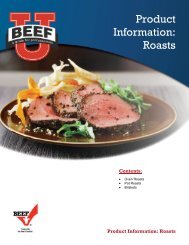Fact Sheet - Beef Foodservice
Fact Sheet - Beef Foodservice
Fact Sheet - Beef Foodservice
You also want an ePaper? Increase the reach of your titles
YUMPU automatically turns print PDFs into web optimized ePapers that Google loves.
Marbling is an important factor in determining the quality grade of a beef carcass,<br />
typically having a positive effect on the palatability of the cooked meat. However,<br />
subcutaneous, seam and internal fats, all factors in determining the yield grade of a<br />
carcass, each have a negative impact on the final yield grade.<br />
Quality Grading<br />
This part of the grading system provides the purchaser with an estimate of the<br />
palatability, or taste appeal (tenderness, juiciness and flavor), of the cooked meat from a<br />
carcass. The quality grade is determined by evaluating the following characteristics of a<br />
beef carcass:<br />
Marbling<br />
“Marbling” (intramuscular fat) is the small flecks of visible fat on the cut surface of<br />
fresh meat. In determining the grade of a beef carcass, the marbling is evaluated<br />
on a cut surface of the Ribeye muscle between the 12th and 13th ribs.<br />
The amount and distribution of marbling is a major criterion for grading beef. The<br />
marbling fat melts during cooking, thereby increasing the juiciness of the meat,<br />
contributing to its flavor and increasing its perceived tenderness.<br />
The “Official United States Standard for Grades of Carcass <strong>Beef</strong>” recognizes ten<br />
degrees of marbling. The six common degrees of marbling are -Moderately<br />
Abundant, Slightly Abundant, Moderate, Modest, Small and Slight.<br />
Maturity<br />
The younger the animal the more likely the meat will be tender, because as the<br />
animal matures, the connective tissue increases in amount, becomes tougher,<br />
and will not break down as easily when cooked. Younger cattle can qualify for<br />
Prime, Choice, Select or Standard. Meat from older cattle (over 42 months of<br />
age) can qualify only for Commercial, Utility, Cutter or Canner grades.<br />
During the grading process, the USDA grader does not have information as to<br />
the exact age of the animal from which the carcass originated. Consequently, the<br />
grader determines the physiological maturity of the animal on the basis of<br />
skeletal characteristics and the color and texture of the Ribeye muscle. The<br />
bones of young animals are soft, porous and red. As the animal gets older,<br />
bones and cartilage ossify, that is, they grow harder and turn white.<br />
The color and texture of the Ribeye muscle is also considered when determining<br />
the final maturity group for carcasses. Young cattle have muscle that is bright<br />
cherry-red and finely textured. The color of beef becomes progressively darker<br />
and the texture coarser as the animal matures.<br />
In determining the physiological maturity of the animal from which the carcass<br />
originates, the grader places each carcass into one of five maturity groups: A, B,<br />
C, D and E. A and B maturity groups represent carcasses from younger cattle<br />
(under 42 months of age), while C, D, and E maturity groups represent carcasses<br />
from older cattle (over 42 months of age).






